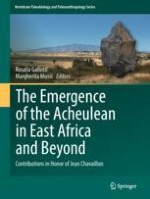In this paper, we present and discuss pollen
data from the Early Pleistocene
(1.8 to 1.6 Ma) – we use the revised timescale approved by IUGS, in which the base of the Pleistocene is defined by the GSSP of the Gelasian Stage at 2.588 (2.6) Ma (Gibbard et al.
2010) – and from the Mid-Pleistocene Transition
(0.9 to 0.6 Ma) at Melka Kunture (Upper Awash
, Ethiopia). At 2000 m asl in the Ethiopian highlands, these deposits yield many rich and successive archaeological sites, notably documenting the late Oldowan, the emergence of the Acheulean and the middle Acheulean. The stratigraphic position of the fifteen pollen
samples is checked by
40Ar/
39Ar dating and by geological investigation. Furthermore, they are now correlated to archaeological layers whose excavated lithic industries have been reinterpreted. Our study shows that mountain forest trees belonging to the present-day Afromontane complex were already established in Ethiopia at ~1.8 Ma and that the knappers of the Oldowan and early Acheulean could cope with mountain climatic conditions that had a large diurnal temperature range. Moreover, the new interpretation of pollen
results emphasizes changes that occurred in the vegetation cover at 200- or 300-thousand-year snapshot intervals, one during the Early Pleistocene and another one later on, during the Mid-Pleistocene Transition
. These changes concerned plant species and their respective abundance and appear to have been related to rainfall and temperature variability
. The proportion of forest trees increased during wet episodes, whereas the influence of Afroalpine grassland indicators increased during cool and dry episodes. Variations in Early Pleistocene
pollen
data from Melka Kunture at ~1.8–1.6 Ma are consistent with isotopic evidence of precession variability
as recorded at Olduvai and Turkana
archaeological sites at ~2–1.8 Ma. For the Mid-Pleistocene Transition
, variations in pollen
data seem to match the climatic variability
of isotopic and long pollen
records from the Mediterranean region, notably upon the onset of dominant 100 ka-long glacial/interglacial cycles.
